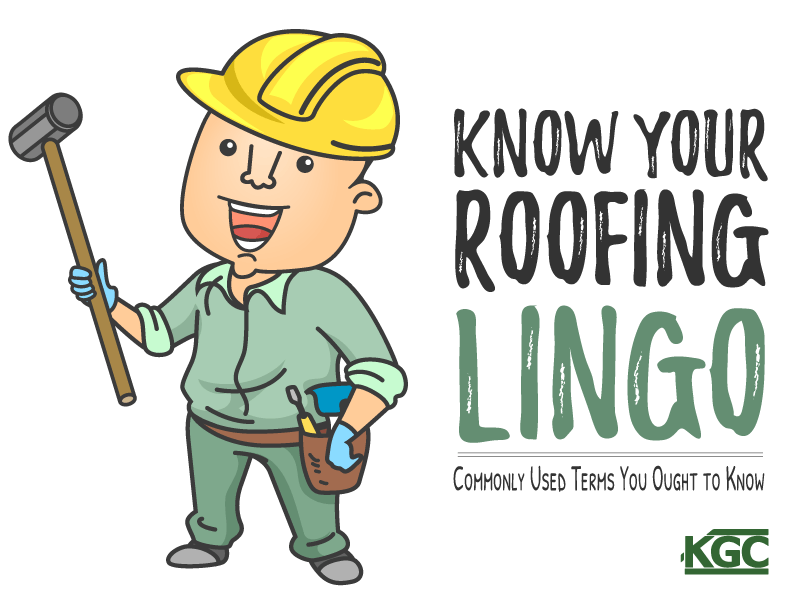Roofing lingo can sometimes feel like a foreign language – but don’t let that put you off getting work done on your roof.
Know how to speak ‘roofing’, and get to know these commonly used terms like the pros.
1. Flashing
The roofer isn’t being inappropriate, but rather is talking about the really important waterproof materials used to coat projections on a roof, such as chimneys, joints, and vents, and seal any part of the roof’s surface that’s interrupted.
Flashing could be corrosion-resistant rubber, metal, plastic, or other materials. It does the crucial job of weather-proofing your roof. There are different types of flashing. Base flashing, for example, is the is the waterproofing of the area where the roof meets the wall.
2. Eaves
When a roofer refers to the eaves of the roof, he (or she) is talking about the lower edge of the roof that extends beyond the house, where the gutters are placed.
Eaves can be decorative and give the house a particular architectural style, but they have a much more important function: to protect the house from the elements by providing an overhang. This way, rain doesn’t fall directly onto the walls. Eave vents are also sometimes placed to provide fresh air into the attic or top floors.
3. Ridges
Just as sharp as the edge of the mountain, the ridge is the highest point of the roof, where the two sloping planes of the roof meet.
A ridge beam, is the topmost supporting beam, while ridge shingles cover and protect the roof.
Sometimes a vent is placed on the ridge to circulate the air in the attic and around the roof elements to avoid condensation. (By contrast, the rake is the part of the roof from ridge to the eaves.)
4. Decking/Roof sheathing
It sounds like somewhere you’d like to relax, but it really isn’t.
Roofers may talk about the decking or the roof sheathing: the base structure of the roof covering. Usually this is made of wood, and laid out large, flat surfaces that are nailed to the roof. The shingles are installed on it.
5. Shingles
Thankfully, the roofer isn’t diseased but is pointing out something about the overlapping, rectangular roof covering material that you see on the roof.
Shingles can be made of several types of materials, but commonly they’re made of asphalt, either standard thickness or laminated. There are more luxurious materials like slate or wood shingles, and it’s worth having a discussion about how long each will last when you’re talking to your roofer.
6. Blister, buckling, blow-offs, and cupping
They’re as nasty as they sound.
Blisters are the air pockets that bubble up on the surface of the shingles.
Blow-offs are the shingles literally blown off the roof deck by the wind or a storm.
Buckling creates wrinkles and a rippling effect on the shingle, and cupping is the curl of the shingle at the corners.
These faults can happen as a result of trapped moisture, a manufacturing issue or faulty installation
7. Rafters
It sounds as if you may be out at sea, but rafters are slopping wooden or metal beams that support the roof below the deck. The roof decking is nailed to the rafters.
8. Roof Slope and Pitch
The real pros will tell you there’s a difference (though they’re commonly used interchangeably now).
Knowing your roof’s pitch and slope will help you and your roofer decide on what products are best to use.
The slope is angle of the incline created by two roof planes, and it’s usually written or spoken about as a ratio of inches per foot to talk about the vertical rise versus the horizontal run. (A 4:12 slope means that the roof rises 4 inches ‘up’ for every 12 inches ‘across’.)
The pitch is also used to determine the incline of a roof, but is a little different. It’s usually expressed as a fraction of the rise to the span (horizontal length of the building), like 1/6.
9. Reroofing and Recovering
What it says on the tin. But while reroofing means completely replacing the roof, recovering means simply overlaying a new roofing system over a roof.
Nesting is a way of reroofing with a second layer of shingles installed on an existing roof deck. This can be done when the shingles are cupping or buckling, as a way to avoid reroofing the entire structure.
So should you reroof or recover your roof? Let us help you decide.
10. Square
In this instance, it’s cool to be square. That’s the measurement most roofers will use in their proposals for costing, based on roof size: one square is 100 square feet (10 x 10 feet).
Feeling more confident now about starting a conversation about roofs? At Keith Green Construction, we’ll blast through the lingo and speak in plain language. Give it a try, and contact us for a quote.


